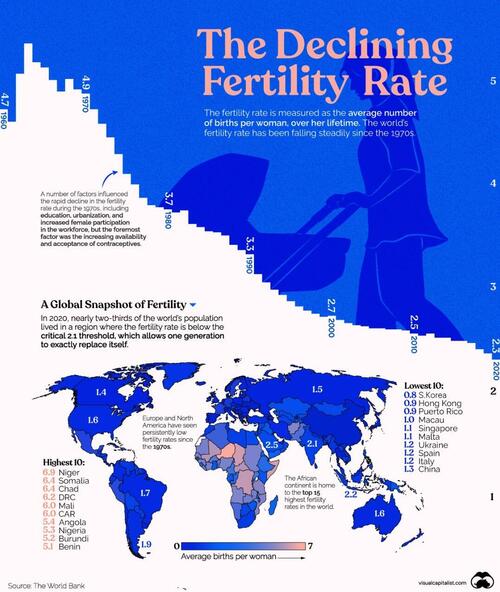
2.1 is the critical threshold for replacement rates.
At the dawn of the 19th century, the world population hit a big milestone: 1 billion people.
Over the next 220 years, the number grew to eight times that, or the 8 billionpeople who live on the planet today, with half of the growth occurring since 1975.
As Visual Capitalist’s Bhabna Banerjee and Pallavi Rao detail below, this continuous climb in global population has been possible thanks to advancements in healthcare and nutrition.
However, the UN forecasts that rapid growth will slow down – and may even stop entirely by 2100 – because of falling fertility rates.
What does that mean for modern nation states conditioned to expect a constant influx of new citizens and labor to power their economies? And how can those changing economies adapt to a shrinking population?
To understand that, we need to first untangle fertility rates, and why they’re falling.
Explained: Fertility and Replacement Rates
The total fertility rate is the average number of births per woman over a lifetime. This measurement makes two key assumptions, however:
The woman will live to the end of her childbearing years
The woman will bear children according to the age-specific fertility rates currently observed
Both assumptions add some uncertainty to future fertility rate projections. However, decades of past data collected by the World Bank help show some overall trends around the world, and in many countries.
The age-specific fertility rate (ASFR) “measures the annual number of births to women of a specified age or age group per 1,000 women in that age group,” according to the UN.
The world fertility rate (expressed as the number of children per woman) has been falling steadily since the 1970s.
In 2020, the world’s fertility rate stood at 2.3, slightly above the replacement rate of 2.1 births per woman, which allows for one generation to replace itself. This is down more than two times from 4.7 in 1960.
But the world’s average hides the vast disparities between the fertility rate of countries. We dive into the differences below.
https://www.visualcapitalist.com/worlds-plummeting-fertility-rate/